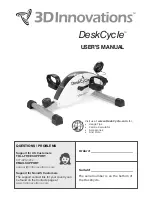
10
FITTING THE HANDLEBAR.-
Position the handlebar (20) on the handlebar stem
(21), Fig.3, tighten the knob (17) and then insert the
handlebar stem (21) into the hole on the main body
(A), Fig.3. Position it correctly and then tighten knob
(17B) by turning it clockwise.
ADJUSTING THE HANDLEBAR HORIZONTALLY.-
Position the handlebar (20) at a comfortable
distance for doing exercise, now tighten knob (17)
securely, Fig.3.
ADJUSTING THE HANDLEBAR VERTICALLY.-
Position the handlebar (20) at a comfortable
distance for doing exercise, now tighten knob (17B)
securely, Fig.3.
Stay within the references 0-14 without going
beyond the “MIN INSERT” mark.
ATTACHING THE SADDLE.-
Fit the saddle bracket (1), Fig.4, onto the horizontal
saddle tube (38), as shown in Fig.4, fit the saddle
into position and tighten the nuts on the bracket
securely.
Next insert the horizontal saddle tube (38) through
the hole on the saddle post (39), Fig.4, position it
correctly and tighten the knob (2), Fig.4.
Insert the saddle post (39) into the boss on the
main body (A), position it correctly and tighten the
saddle post by using the adjustment knob (2A),
Fig.4, turning it clockwise.
ADJUSTING THE SADDLE HEIGHT.-
Loosen the saddle post adjustment knob (2A)
slightly by turning it anticlockwise, Fig.5, move the
saddle to a position comfortable for doing exercise
and then tighten the adjustment knob (2A) securely
by turning it clockwise.
Stay within the references 0-19 without going
beyond the “MIN INSERT” mark.
HORIZONTAL ADJUSTMENT OF THE SADDLE.-
Loosen the knob (2) slightly by turning it
anticlockwise, Fig.5, move the saddle to a position
comfortable for doing exercise and then tighten the
knob (2) securely by turning it clockwise.
Stay within the references 0-17 without going
beyond the “MIN INSERT” mark.
FITTING THE PEDALS.-
The assembly instructions for the pedals must be
followed to the letter, fitting these incorrectly could
damage the screw thread on either the pedal or the
crank.
Right and left refer to the position that the user adopts
when sitting on the saddle to do the exercises.
The right-hand pedal (9R), marked with the letter (R),
screws onto the right-hand crank, also marked with an
(R), in a clockwise direction. Tighten securely, Fig.5.
The left-hand pedal (9L), marked with the letter (L),
screws onto the left-hand crank, also marked with an
(L), in an anti-clockwise direction. Tighten securely,
Fig.5.
Remove screws (16) located on the main post (A) and
fit the bottle holder (15), using the same screws (16).
FITTING THE ELECTRONIC MONITOR.-
Take off the screw of the back of the monitor (92).
Place the monitor (92) in the direction of the arrow
sliding the monitor on the Bracket plate (M) Fig.6
Place the nolding plate (113) and fix it with the
screw (71).
Slide the monitor (92) onto the monitor bracket,
Fig.6, I., secure the monitor to the bracket with the
previously removed screw.
Next, connect the monitor cable (86) to the back of
the monitor (92) and make sure the other side of
the cable (86) is connected securely to the cable
coming from the frame. Additionaly, make sure that
the cable stopper (93) is plugged into the hole that
the lower cable connections came through, Fig.6, II.
EXERTION SETTINGS.-
For regular control of exercise settings, this
appliance is equipped with a tensioning control
(22), located on the stem of the main body (A) Fig.7
which, when lifted in the direction of the arrow,
indicates the resistance settings of the appliance in
the monitor.
To increase the pedalling resistance, lift the
tensioning control (22) until the exertion level best
suits your exercise requirements.
To decrease the pedalling resistance, lower the
tensioning control (22).
Important:
This tensioning control (22) has an
emergency braking system which, when fully lifted
in the direction of the arrow, as shown in Fig.7,
causes a sudden braking force for the flywheel.
LEVELLING.-
Once the unit has been placed into its final position,
make sure that it sits flat on the floor and that it is
level. This can be achieved by screwing the
adjustable feet (10) up or down, as shown in Fig.7.
MOVEMENT & STORAGE.-
The unit is equipped with wheels (13) Fig.7, to
make it easier to move. The wheels located at the
front of your unit make it easier to move it into a
chosen position, by lifting the rear of the unit up
slightly and pushing it, as shown in Fig.8. Store
your unit in a dry place, preferably not subject to
changes in temperature.
OPERATIONS BEFORE BEGINNING
1.- Check that all components are properly installed:
The nuts of the stands must be tightened with a torque
of 20 Nm.
The pedals must have been sealed with Loctite 242
and tightened with the appropriate torque (a 46 Nm
torque must be applied).
The saddle and handlebars must be properly adjusted
for the user.
2.- BH rust inhibitor (110) must be applied to the
contact surfaces indicated in Figures 11 to 16.
Points of application for BH rust inhibitor(110):
Содержание LK700IC
Страница 2: ...2 Fig 1 Fig 2 Fig 3...
Страница 3: ...3 Fig 4 Fig 5 Fig 6 Fig 7 Fig 8...
Страница 4: ...4 Fig 9 Fig 10 Fig 11 Fig 12 Fig 13 Fig 14 Fig 15 Fig 16...
Страница 17: ...17 LK700IC...







































